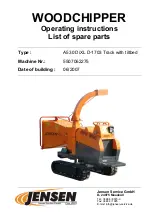
Chill V Series
5. Operating Panel (con’t)
Set Value Setting:
In basal display status, we can set the set-point (SV) by pressing
or .
Press
to decrease the value, to increase the value, and to move
to the digit expected to modify. Keep pressing or , to speed up the decreasing
or increasing of the value.
Parameter Setting:
In basal display status, press and hold for about two (2) seconds in order
to access Field Parameter Table. Pressing can go to the next parameter;
pressing or can modify a parameter. The instrument will escape
automatically from the parameter table if no key is pressed within 30 seconds.
Intelligence control and auto tuning
When the “At” control method is chosen, the control parameters can be obtained by
running auto-tuning. At the first time of running auto-tuning, in basic display status, “At”
will flash in the lower display window and the instrument executes on-off control. After
two (2) to three (3) cycles of on-off action, the instrument will obtain the values of PID
control parameters. If you want to escape from auto tuning status, press for about
two (2) seconds until the “At” flash stops. Depending on the system, the time of auto tuning
can be several seconds to several hours. After the auto tuning finishes, the parameter “At”
automatically changes to “OFF”. If the user wants to run auto tuning again, set the setting
parameter from “At” to “on”.
Note 1:
Before running auto-tuning, the set-point should be set to an often-used value
or middle value first, and then start auto-tuning. Generally, for applications with heating
time of 10~80% satisfying auto-tuning results can be obtained. If the heating time is not
in the range of 10~80%, the auto-tuning will continually run, searching for satisfying
result. Raising the set-point for heating time less than 10% or decreasing the set-point
for heating time greater than 80% can improve auto-tuning result.
Note 2:
Don’t modify the set-point during auto-tuning. It may affect the precision of auto-tuning.
Note 3:
The temperature fluctuation caused by interference may affect the precision of
auto-tuning. Besides checking the wiring, increasing the parameter FILt (input digital filter)
can also reduce interference.
Note 4:
After auto-tuning finishes, the temperature rising typically has a little over-shoot
(about 1~3°C). The transducer is often placed between the heater and heated material,
and a little over-shoot can shorten the time of rising to set-point and save power. (Generally,
the temperature of the transducer can be raised quickerthan that of the heated material.)






























